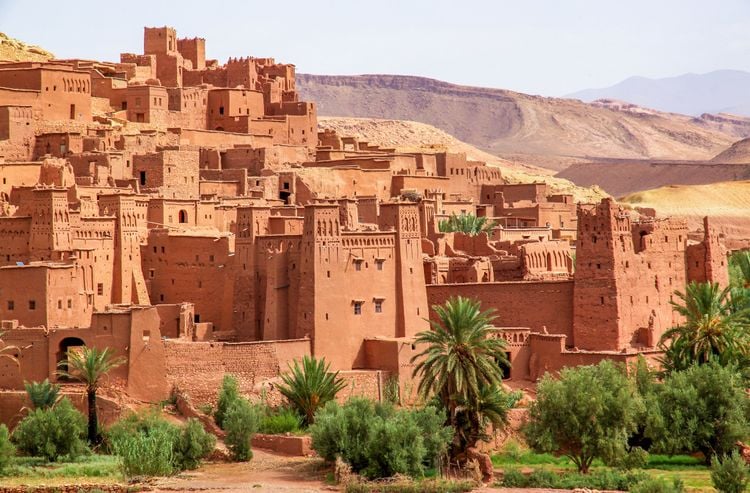Arriving in the medina of Fez is like stepping back in time. Just 2 hours 50 minutes from Paris, Morocco's cultural capital is so close and yet so far away. Since it was founded in 789, the narrow streets of the Fès medina have remained virtually unchanged, and the smells, colours and ambient noise of the bustling city are still the same. There are two magnificent gates leading into the medina: the best-known and oldest is the Bab Boujloud, also known as the Blue Gate, to the west of the old town.
Far less well known than Marrakech, Agadir or Essaouira, the towns of northern Morocco are well worth a visit for their diversity of landscapes, their typical crafts and the wide range of activities they offer. From Fès, the country's cultural capital, to Chefchaouen, nicknamed the Blue City, we discover another face of Morocco, but one that is just as charming. Fez, Tangier, Tetouan and Volubilis are just some of the places to visit to immerse yourself in this little-known facet of the Kingdom of the Setting Sun. Here's a one-week itinerary to discover authentic villages, unspoilt archaeological sites and modern cities, via the mountains and the Atlantic and Mediterranean coasts. Follow the guide as we take you on a discovery tour of northern Morocco.

Morocco lies on the shores of both the Atlantic and the Mediterranean.
- © Alfonso Galisteo Zurera / ShutterstockDay 1: Head for Fez, the cultural capital
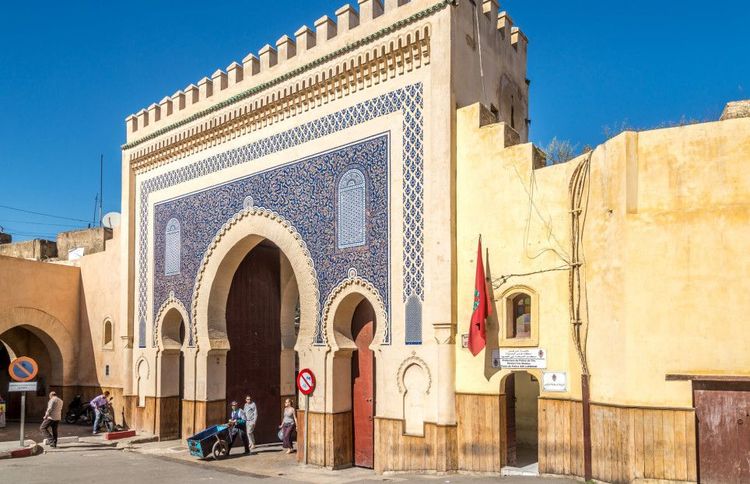
Bab Boujloud, the blue gate marking the entrance to the medina of Fez in Morocco.
- © milosk50 / shutterstockOnce inside the walled medina, you're drawn in by the crowds wandering from stall to stall. Follow the smells of olives, cumin and grilled meats to sample the local food and stock up on Moroccan pastries. In the souk, everything is organised: food, beauty, traditional clothes, handicrafts, each product has its own area.
Head for the Place Seffarine to see the copper-smiths at work. This isone of the oldest trades in Fès. You can also buy teapots, copper trays and all sorts of handicrafts created in this historic square.
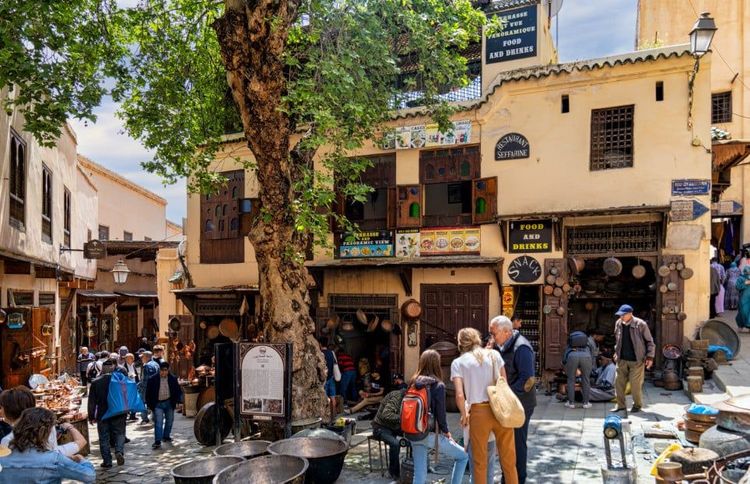
Place Seffarine in Fez, Morocco.
- © BZ Travel / shutterstockA visit to the souks of Fès el-Bali quickly reveals that leather is one of the major assets of Moroccan craftsmanship. Wallets, bags and shoes are just some of the items you can buy to make quality gifts at low prices. To realise just how important this craft is, head for the Chouara tannery, located near the mosque and Al Quaraouiyine University (the oldest in the Arab-Muslim world), to discover the traditional method of leather production.
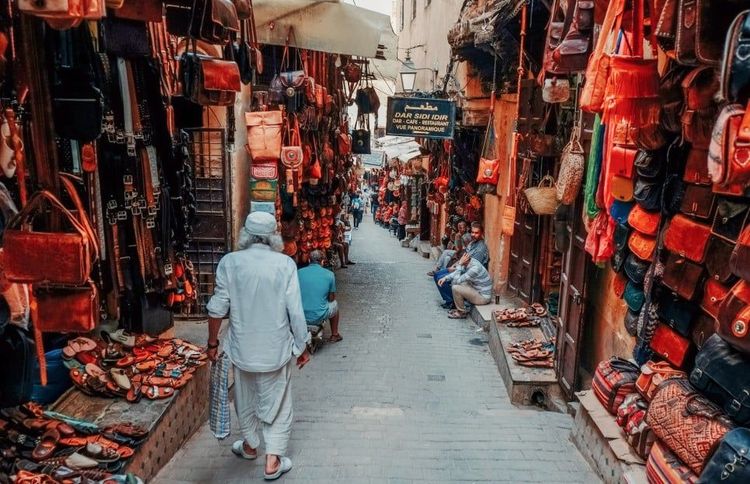
The souk in Fez, Morocco.
- © Alessio Catelli / shutterstockThis is the most typical place in the city, where you can watch the tanners introduce animal skins into vats filled with natural dyes. It's a colourful spectacle that gives you an insight into the age-old technique of mixing pigeon droppings with lime in jars. At the entrance to the tannery, a vendor will give you a sprig of mint so that you can breathe in the fresh air while observing this panorama that takes us back to the 8th century.
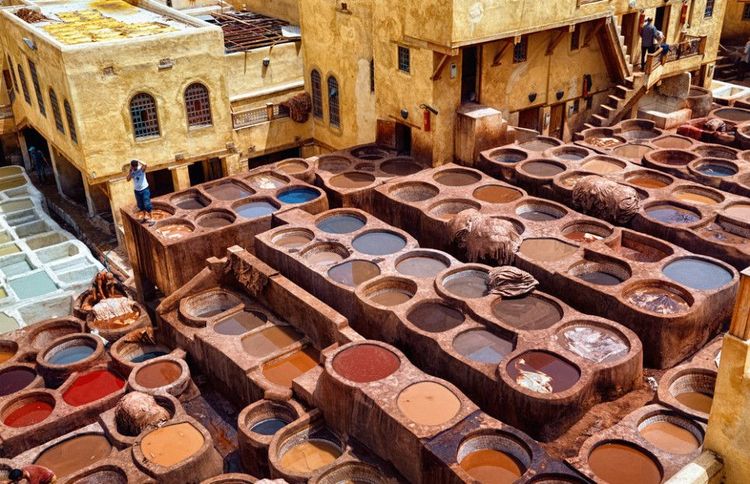
The Chouara tannery in Fez, Morocco.
- © Alexey Pevnev / shutterstockWhen night falls, it's off to the riad where we're staying. The rooftop bar allows you to enjoy a drink while taking in the panoramic view of the illuminated medina, making for some pretty Instagrammable photos.
 Fez
Fez
Riad Braya 5* - Fez
In the historic heart of Fez, this typical riad welcomes visitors to a luxurious and soothing setting.Day 2: The Merinids' tomb and Volubilis
Before heading north, we enjoy breakfast by the pool in our riad, a haven of peace in the medina. Then it's on to the new town to discover the great modern avenues dotted with palm trees, fountains and shops.Avenue Hassan II is a long tourist promenade with numerous shops, cafés, restaurants, hotels and cinemas. The contrast with the medina is striking.
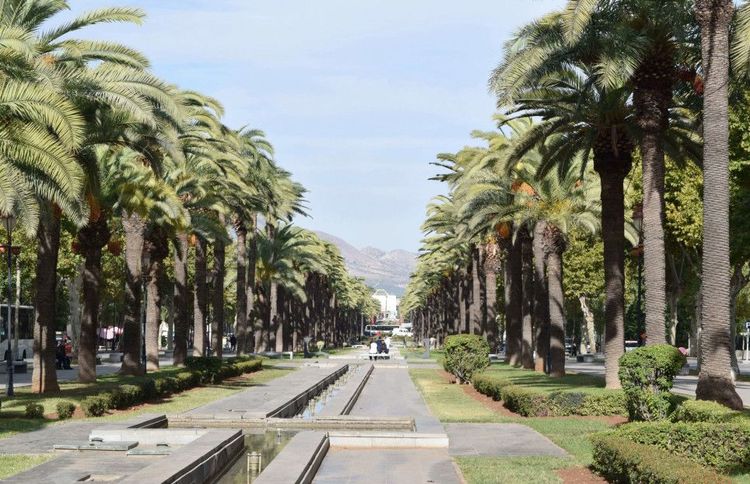
View of avenue Hassan II in the new city of Fez, Morocco.
- © taravelworld1971 / ShutterstockOn your way out of town, make sure you stop off at the Merinids' tomb. This is the resting place of the last sultans of Morocco. The Marinids founded the Fès el-Bali medina between the 13th and 15th centuries. Although the site has lost some of its splendour over time, it is still a must-see for its historical significance and the view it offers over the city of Fès. Situated on the El Qolla hill, the site is ideally placed for watching the sunrise or sunset.
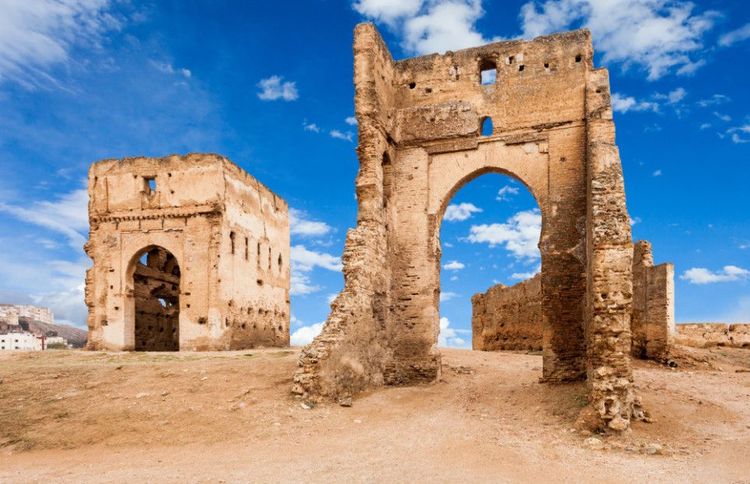
The Merinid tomb on the hill of Fez in Morocco.
- © saiko3p / ShutterstockThis short break was a foretaste of the archaeological remains awaiting us 1h15 from Fez. We headed for Volubilis, for an afternoon dedicated to Ancient Rome. This site is an ancient Roman city whose ruins and intact remains date back over 2000 years, no less! Impressive and steeped in history, Volubilis bears witness to the passage of various civilisations between the 3rd century BC and the 11th century AD, from Romans to Berbers, Greeks, Syrians, Jews and Muslims.
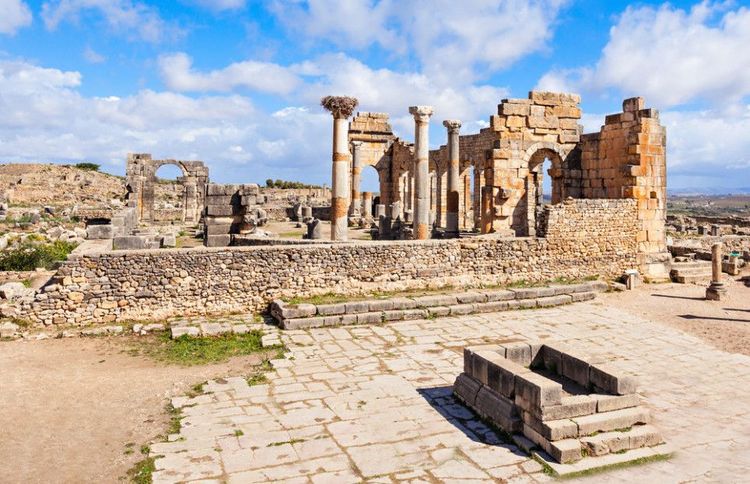
Le site archéologique de Volubilis près de Meknès au Maroc.
- © saiko3p / ShutterstockThis UNESCO World Heritage site is one of Morocco's jewels. On your own or with a guide, you can explore the forum, the basilica, the Temple of Jupiter, the thermal baths and the Arch of Caracalla, built in 217 AD. Be sure to take a look at the mosaics that adorn several of these sites.
After this visit from another time, head for Tangier, just over three hours away. The city, which facesSpain on the Strait of Gibraltar, enjoyed a golden age between the 1950s and 1970s. Many artists and musicians found refuge and inspiration here. We put down our suitcases in a riad in the heart of the medina so that we could visit it the next day. The room's terrace offers an unobstructed view of the illuminated city of Tangier, enough for sweet dreams.
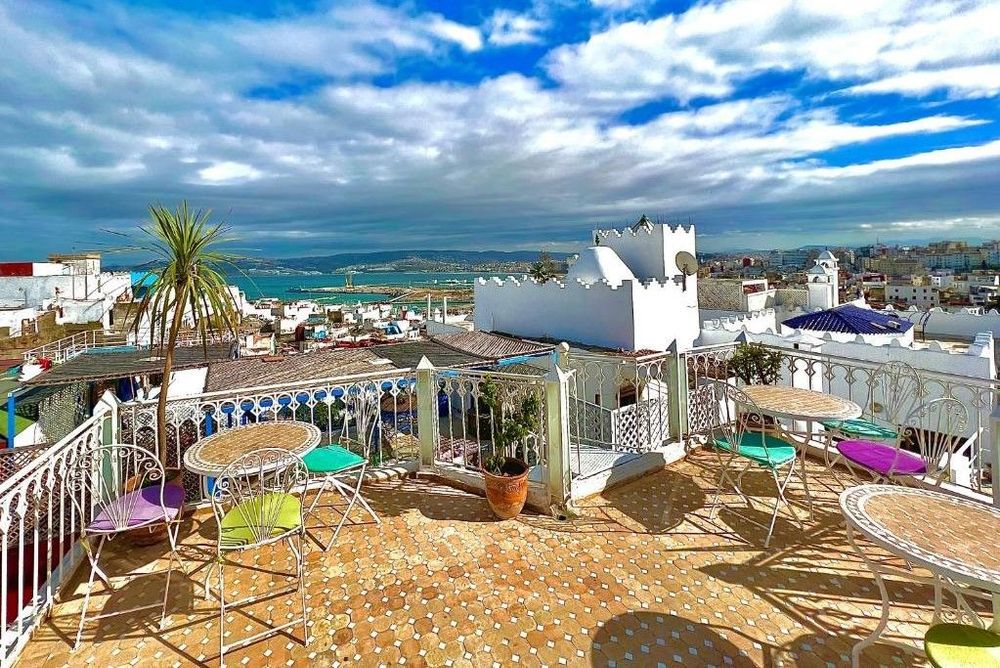 Tangier
Tangier
Kasba blanca
The real highlight of this Tangier bed and breakfast is its terrace with a panoramic view of the marina! Its traditional rooms are also very comfortable.Day 3: Visit to Tangier
With its narrow streets, numerous stalls and walls with white or blue facades, Tangier's old town is an inviting place to stroll around. The most legendary spot is the Place du Petit Socco, where many Tangiers locals gather for a cup of tea or to shop. The market is a maze of colours and smells, with spices, olives and the city's famous honey pastries. The ideal place to relax is on the terrace of a café, watching the bustle of life in the district.
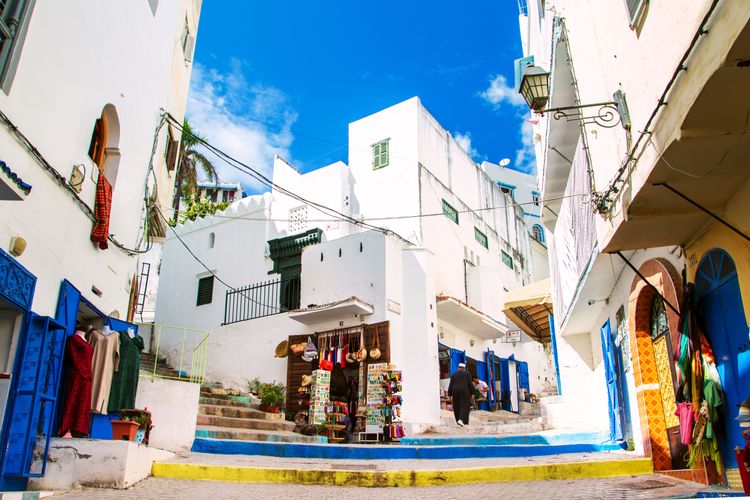
The old medina of Tangier.
- © Lizavetta / ShutterstockAs you wander through the narrow streets, you will come across the Great Mosque and its 17th-century architecture, and then on to the Kasbah Museum, a former palace with exhibitions that showcase Mediterranean cultures and the diversity that reigns in Tangier through all kinds of objects and works of art.
A little further on, behind the Bab el Fahs gate, the Grand Socco stands out. This is a large souk of shops selling a wide range of Moroccan handicrafts, including fabrics, carpets, teapots and various types of leather accessories. It is located on the boundary between the medina and the new town, and is accessed via the Bab el Fahs gate. Just a few steps from the square are the Ciné Rif, the Théâtre Cervantès and the Ciné Alcazar.
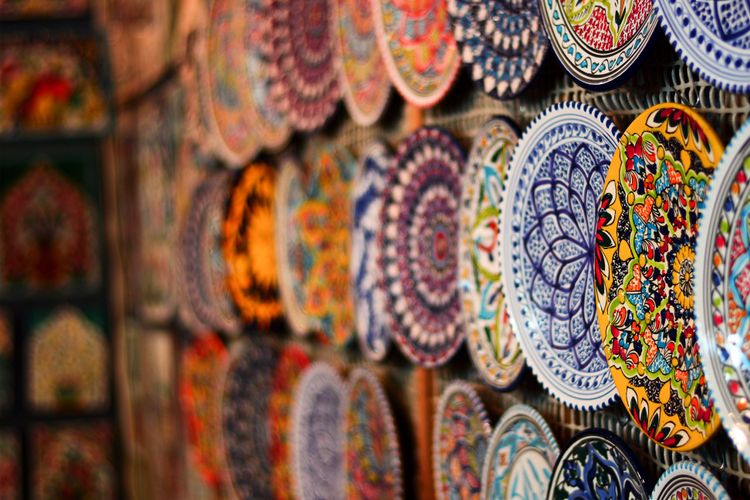
The souks are full of treasures.
- © Corrado Baratta / ShutterstockAfter lunch in one of the restaurants on the square, head for the Marshan district, just a few hundred metres from the medina. Ideally located, this district offers incredible views of the sea. Discover the Marshan gardens, the Royal Palace and the small Mendou Palace, or the Phoenician Necropolis, before heading to the legendary Hafa café.
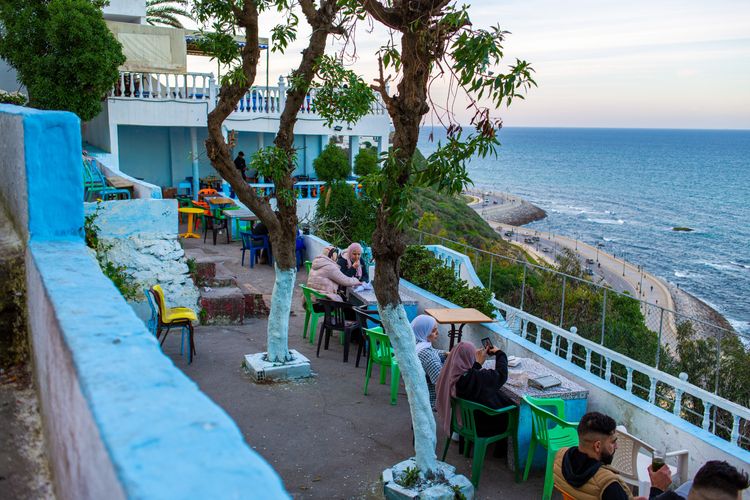
The terrace of Café Hafa in Tangier.
- © Castling Short / ShutterstockFounded in 1921, the café offers a panoramic view of the sea and its shades of blue as you descend the stairs to the terraces. Café Hafa owes part of its worldwide reputation to the many celebrities who have passed through its doors, including the Rolling Stones, Jimi Hendrix and Sean Connery. A place not to be missed!
Day 4: Hercules caves at Cap Spartel
Located 14 km from the centre of Tangier, the Hercules caves are well worth a visit during a stay in northern Morocco. These are former quarries that have now become limestone caves that can be visited. Small in size, these caves give access to several rooms and offer a moment of coolness when the outside temperatures are high.
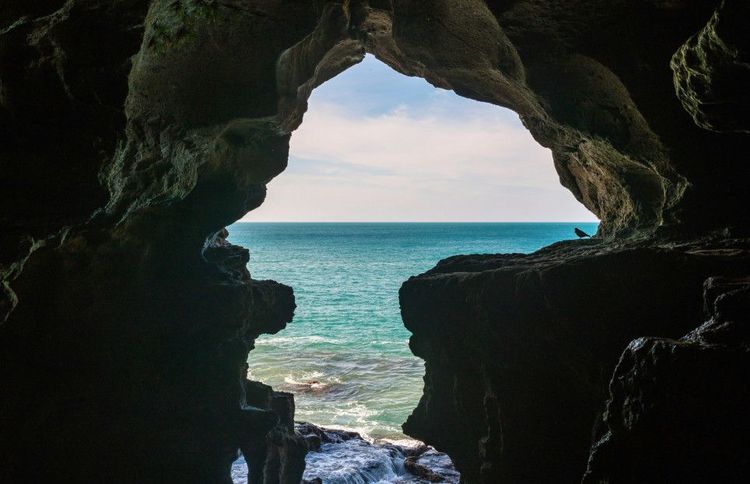
The Hercules caves in Tangier, northern Morocco.
- © praphab louilarpprasert / ShutterstockThe caves are unique in that they have an opening onto the sea that fires the imagination. Some see an inverted map of Africa, while others imagine a face in profile. The name of these natural wonders comes from Greek mythology. According to legend, the caves were the home of Poseidon and a favourite spot for Hercules, who took refuge here to rest after a long journey.
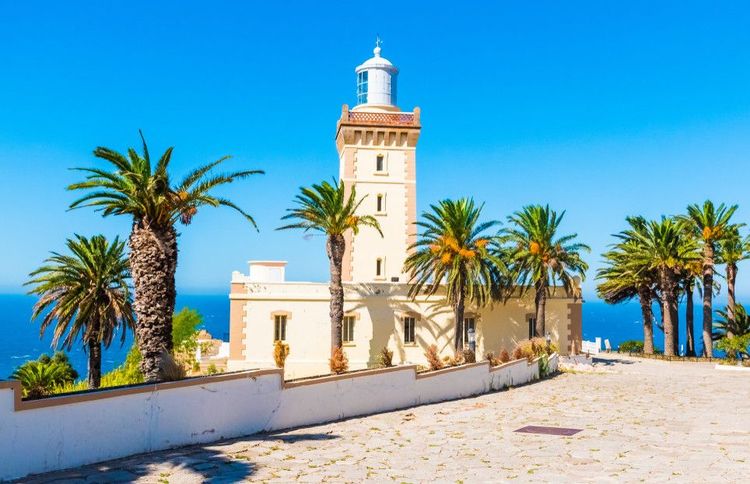
Cape Spartel lighthouse, west of the Strait of Gibraltar near Tangier.
- © Pavel Szabo / ShutterstockNot far from the Grottes d'Hercule, we head back towards Cap Spartel, a promontory on which a 19th-century lighthouse is nestled. This is where the Mediterranean Sea and the Atlantic Ocean meet. The panorama, surrounded by greenery and palm trees, is breathtaking.
Below, a beach with turquoise waters stretches for 45 km, but beware of the currents, which can be strong. Near the lighthouse, there are several cafés and restaurants serving traditional fish and meat dishes. The view is magnificent and becomes magical at sunset.
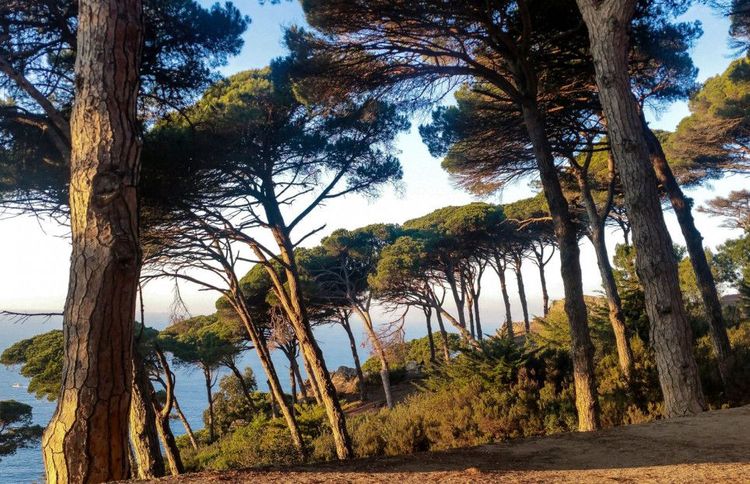
The Perdicaris forest in Tangier, Morocco.
- © Youssef Azougagh / ShutterstockOn the way back to Tangier, where we'll be spending the night again, a stop at the Perdicaris park is a must. This 67-hectare botanical park is home to numerous species of trees, including acacias, laurels and pines. If you're lucky, you might even catch a glimpse of the migratory birds that find refuge here on their long journeys. What more could you ask for than a green setting overlooking the Strait of Gibraltar?
Day 5: Head for Asilah, the Essaouira of the North
Little-known to tourists, Asilah is a small seaside town 40 minutes from Tangier. Although its colours give us a foretaste of Chefchaouen, it is far less touristy than the latter. In its architecture, the town retains the vestiges of a past when the Spanish and Portuguese fought it out. With its white houses with blue shutters, 16th-century ramparts, fishing port, cliffs and long stretch of beach, Asilah seems straight out of a fairytale.

The medina of Asilah near Tangier, Morocco.
- © José Carlos Serrano / ShutterstockThe best thing to do is stroll through the narrow streets, looking up to admire the street art adorning the white walls, enter the boutiques and visit the many art galleries. Asilah is an arty place par excellence, so head to the Raïssouni Palace to see for yourself. Built in 1909, the palace is impressive for the beauty of its architecture, with its wrought-iron balconies and zellij tiles. People come here to discover permanent and temporary exhibitions and to visit artists' studios.
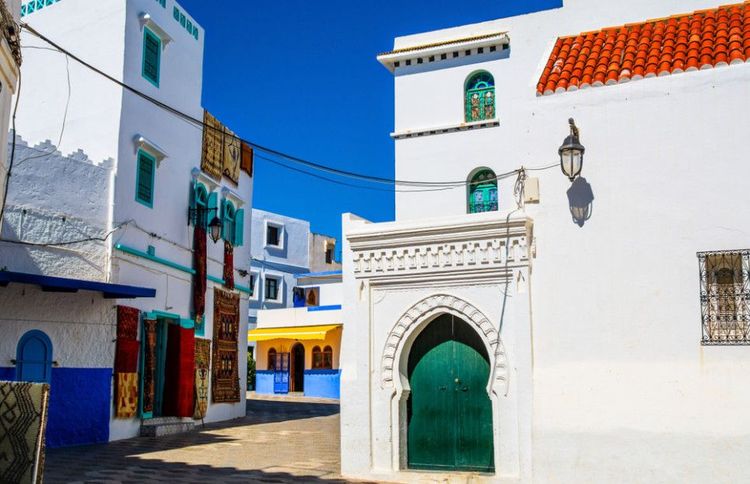
The narrow streets of Asilah's medina.
- © Olena Tour / ShutterstockAt lunchtime, there are plenty of restaurants for lunch overlooking the medina or the port. As theSpanish influence is still present in Asilah, there are a number of restaurants where you can sample Spanish specialities. In front of the town's ramparts, there are restaurants with lovely terraces serving typical dishes, with a wide choice of tajines and fresh fish.
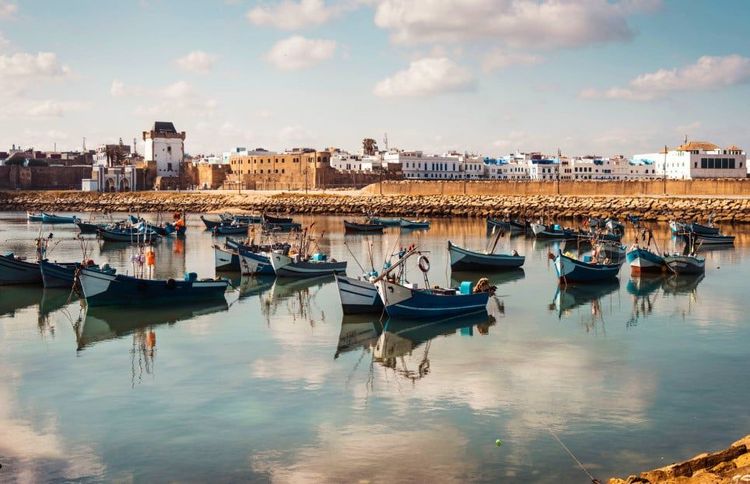
Fishing boats in the port of Asilah, Morocco.
- © Luisa Puccini / ShutterstockThe discovery of Asilah takes a good two hours and after a hearty lunch we continue the day in Tangier to discover its beaches before strolling along the marina. The port of Tangier has developed since it was linked to the city with the construction of the Marina Bay in 2019.
It is a living and leisure space for locals and tourists alike. Here you can eat, have a drink or a coffee, enjoy occasional entertainment and take in the view of the water and the boats. In the evening, you can enjoy tapas in a festive atmosphere, and the marina's restaurants often organise live music in their establishments.
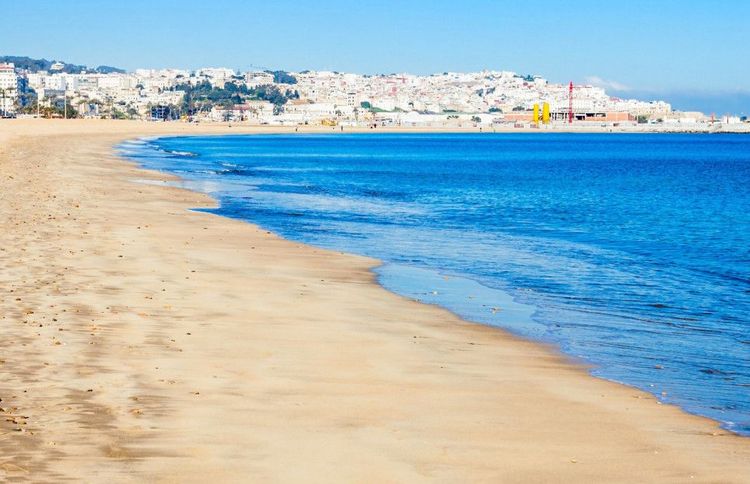
Tangier beach, Morocco.
- © saiko3p / ShutterstockDay 6: Tetouan to Chefchaouen
The last two days of our trip are devoted to Tétouan, the white city, and Chefchaouen, the blue city. From Tangier, it takes around 1 hour 15 minutes to reach the town of Tétouan, which faces the Rif mountains. On the road, you get a glimpse of a Morocco we know less about, far removed from the urbanised cities with their tall buildings.
As we pass through the countryside and mountain villages, we see women working in the fields and peasants wearing their traditional hats with colourful tassels. You can see the Rif mountains as you pass by an artificial lake with turquoise waters, the Ennakhla dam at Jinat. A stop to contemplate this dazzling nature and take some photos is a must.
Tetouan is a must-see when visiting the north of Morocco, thanks to its monuments and architecture. Also known as the "White Dove", the town's buildings bear witness to its Spanish past. Their wrought-iron doors, windows and balconies are reminiscent ofAndalusia.
On the main avenue Hassan II, you'll find a variety of shops and street food for a quick lunch as you make your way towards the Place Hassan II. Here, tourists and locals alike can enjoy views of the Royal Palace, the old town and the mountains.
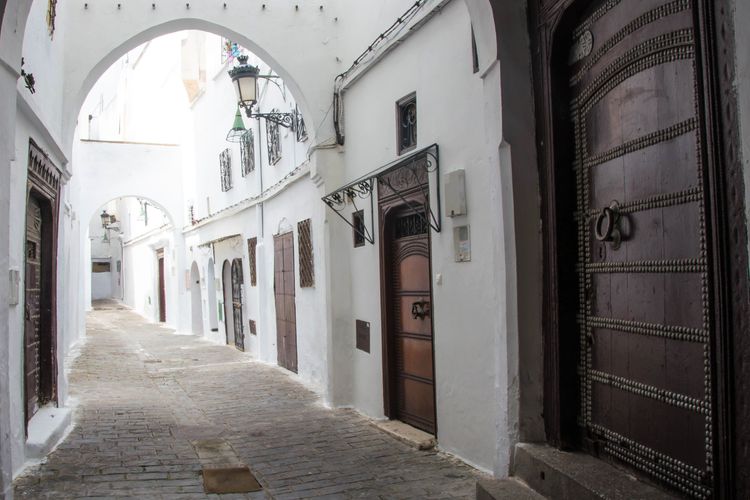
The streets of Tetouan, Morocco.
- © Hind Wanders / ShutterstockWe then head off into the walled medina to lose ourselves in the narrow streets and admire the white-fronted buildings. Listed as a UNESCO World Heritage Site, Tetouan's medina is one of the smallest in the country. In the souk, each activity is represented and located in a specific street, so if you want to buy souvenirs made of leather, wood or copper, or bring back spices, you've come to the right place!
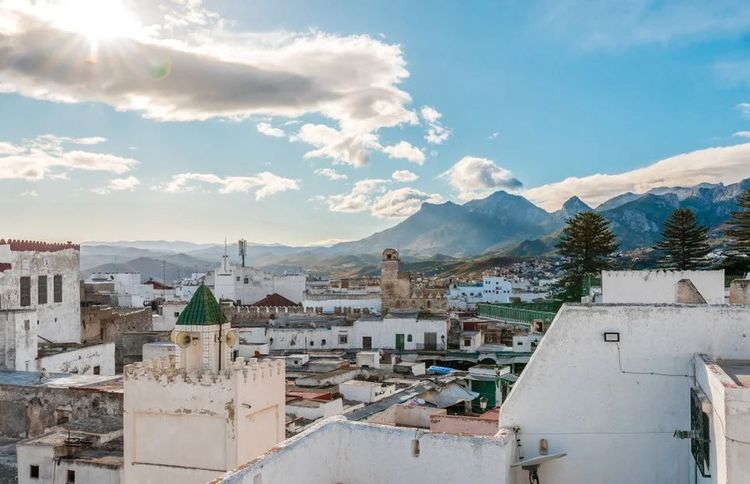
Tetouan and the Rif mountains in Morocco.
- © mbk photographer / ShutterstockThe expression "save the best for last" was never truer than on this week-long road trip. After an hour's drive, we arrived in Chefchaouen. From a distance, we could see the blue city towering above us, and we were already under its spell. We put our bags down at the hotel before setting off to explore the town in less than 24 hours.
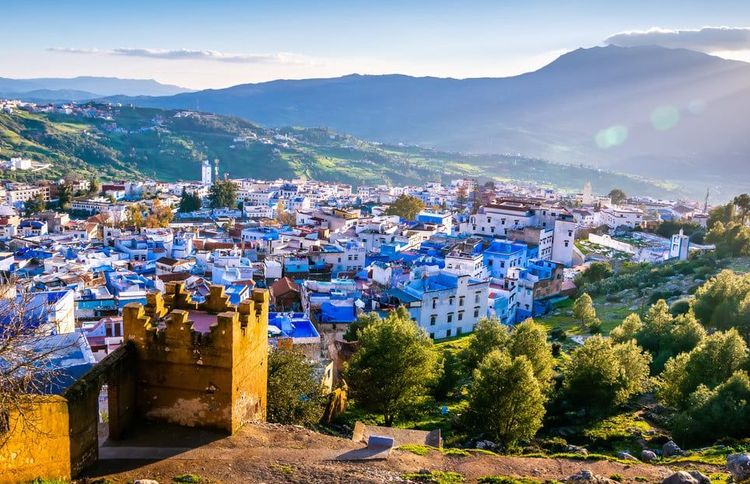
View of the town of Chefchaouen in Morocco.
- © Olena Tur / ShutterstockFounded in the 15th century, the medina is built around Andalusian-Moorish architecture. Its whitewashed walls have been painted blue using a special pigment. And to blend in with the decor, the windows and doors feature shades of the same colour, plunging us into a world apart, almost fairytale-like.
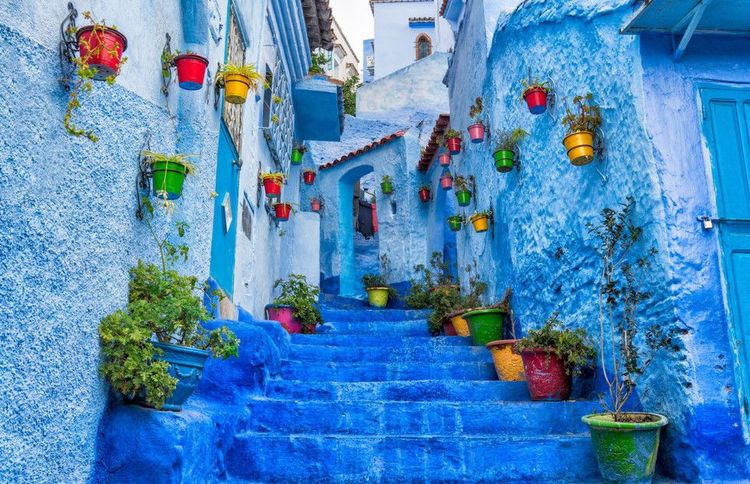
The blue and flowery facades of Chefchaouen's medina.
- © LABGHAIL MOHAMMED / ShutterstockThe ideal route is to follow the stream that leads to the spring around which the village was built. It's also worth getting lost in the sloping paths, stopping to take photos of this magical, flower-filled place and visiting the craft shops. Near the spring, a few children play football on the water-filled ground while families enjoy a juice or a snack in one of the establishments facing the stream. The scenery is dazzling.
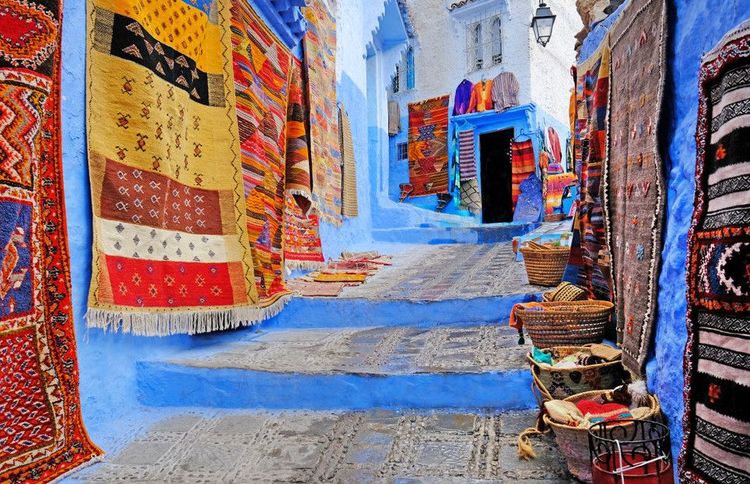
A Moroccan handicraft store in Chefchaouen, Morocco.
- © Vixit / ShutterstockChefchaouen has an authentic local craft industry thanks to the raw materials found in the region. Weaving, embroidery, leatherwork- the town enjoyed a golden age in the 20th century. You'll find these crafts in every shop in the medina, so take the time to stop and admire the meticulous workmanship and stock up on souvenirs. As night falls, we dine at the hotel restaurant. It's Friday, couscous day, so don't hesitate to choose from the menu!
 Chefchaouen
Chefchaouen
Dar Jasmine 4* - Chefchaouen
In the heights of Chefchaouen, this luxurious 4-star hotel offers visitors just the right blend of tradition and modernity.Day 7: Visit to the kasbah of Chefchaouen before departure
The next morning, breakfast awaits us in the Place de Outa El-Hamman. Always lively, this square is close to the Great Mosque and, above all, opposite the imposing Kasbah, built in the 15th century. The perfect opportunity to visit it and discover the ethnological museum inside. Permanent collections focus on the traditional art of the northern region.
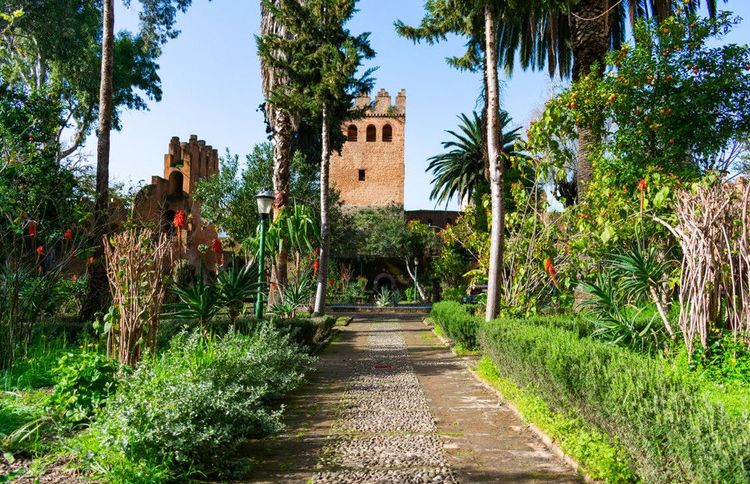
A garden inside the kasbah of Chefchaouen.
- © James Andrews1 / Nicolas BryantAfter a final Moroccan lunch, it's time to get back on the road to Tangiers airport. The images of this fabulous journey will stay with us for a very long time!
